| |
 |
THICK-KNEES Burhinidae |
- 10 species world-wide
- DR personal total: 10 species (100%), 7 photo'd
|
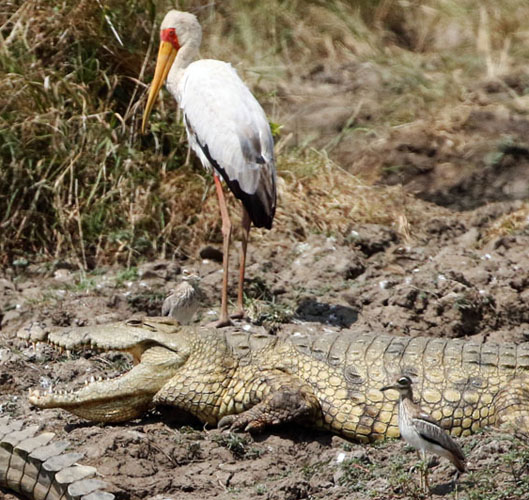 Thick-knees are a small family of terrestrial waders, found in drier country in tropical lands around the world. Other names used for these birds are "Stone-Curlews" or "Dikkops." Eurasian Thick-knee Burhinus oedicnemus is still usually called Stone-Curlew in Europe, and the term Dikkops is still very widely used in southern Africa. The ten species of thick-knees are divided into two genera. Thick-knees are a small family of terrestrial waders, found in drier country in tropical lands around the world. Other names used for these birds are "Stone-Curlews" or "Dikkops." Eurasian Thick-knee Burhinus oedicnemus is still usually called Stone-Curlew in Europe, and the term Dikkops is still very widely used in southern Africa. The ten species of thick-knees are divided into two genera.
Eight of them are rather similar big-eyed, long-legged species in genus Burhinus, found from Europe and Africa through tropical Asia to Australasia. These are all nocturnal foragers that spend the day roosting, often in the shade, but some species roost at safe spots in the open near water. Water Thick-knee (above, left, and below left) is one of those species. There are six Water Thick-knees, and a Little Egret, among three Nile Crocodiles (above). The closer shot (left) focuses on two thick-knees, joined by a Yellow-billed Stork, around one crocodile. Note how amazingly camouflaged the thick-knees are in these tableaus from Tanzania. A close-up of Water Thick-knee in Kenya is below (below left).
I suppose that thick-knees do have thick "knees" (actually "ankles" if compared to human bones) but not much more than other similar waders. The two species of Esacus thick-knees do have very big bills and dramatic black-and-white facial patterns. Great Thick-knee (below right) is the largest species in the family, and boasts the longest and heftiest bill. |
|
Both Water Thick-knee and Senegal Thick-knee Burhinus senegalensis, which replaces Water Thick-knee in the Sahel — stretching across Africa from Senegal and The Gambia to north Kenya — are birds that stand out in the sun near water during the day. Senegal Thick-knee lacks the white bar above the pale gray wing panel but is otherwise very similar in plumage. Not only are they found among crocodiles, but I've seen them standing around in at mid-day at little mud-holes or along slow moving rivers.
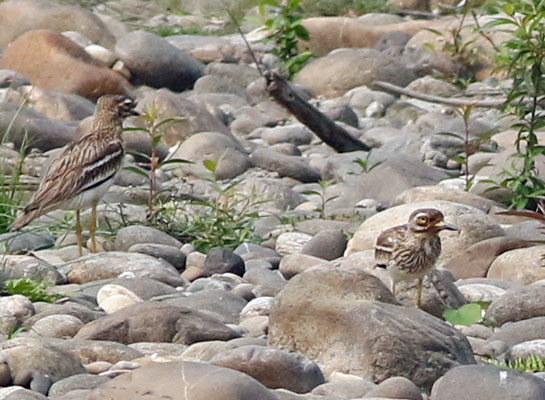
A gray wing panel is also a feature of Eurasian Thick-knee Burhinus oedicnemus, usually called Stone-Curlew in Europe, and the closely related Indian Thick-knee to the east. Eurasian Thick-knee is widely if thinly spread across the Western Palearctic (including north Africa). It may be the best known species to those living in the Old World, but is actually a challenge to locate for an American birder. Nesting locales in England, for example, are quite few and sometimes information is not readily forthcoming. The Indian Thick-knee (right), exquisitely camouflaged by it cryptic plumage among the rocky shores of an Indian river, is found from the Indian subcontinent to southeast Asia. At Bharatpur reserve, India, the species is found in patches of dry woodland and hard to find without specific details. Both Eurasian and Indian Thick-knees are declining in many areas due to human disturbance or habitat loss.
All these species have striking black-and-white wing patterns in flight. All give loud, piping calls and cries at night. |
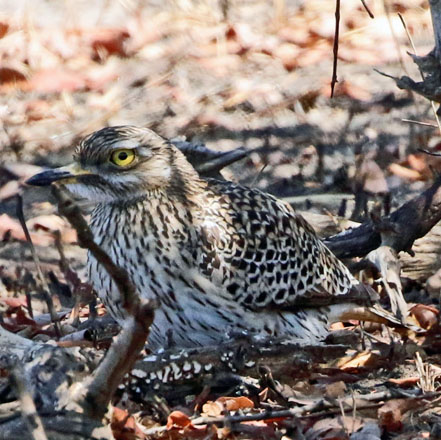 |
Spotted Thick-knee, a widespread species in sub-Saharan Africa (both photos), seems much more like the nocturnal bird is is, hiding under bushes or lying deep in the grass during the day. The huge yellow eyes are for night vision, and the entire upperparts are spotted, without a gray wing-panel. These shots are from Tanzania (left) and South Africa (right). |
 |
|
In Australasia, Bush Thick-knee (near right) becomes the dry country thick-knee, often far from water, as is Spotted Thick-knee in Africa. It also has big yellow eyes. During the day it stands around in the shade of small trees or readily sits in the shade. It is common in some north Australia cities, including Brisbane and Darwin. It forages at night, and gives an eerie wailing cry.
In the Neotropics are Double-striped B. bistriatus and Peruvian Thick-knees. Double-striped is patchily distributed in grasslands from Mexico to llanos of Venezuela and north Brazil, plus Curaçao and Hispaniola. Peruvian Thick-knee (far right) occurs in the coastal deserts of western South America. It is a plainer bird than other burhinids, with a contrasting black head stripe most prominent. I have seen it on Peruvian beaches as well as dry fields. |
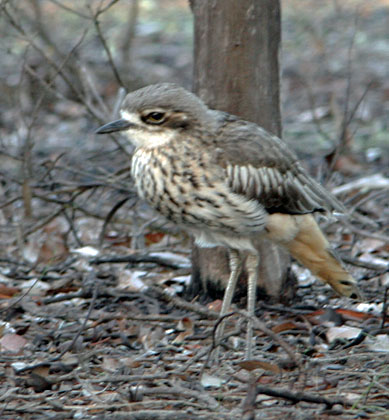 |
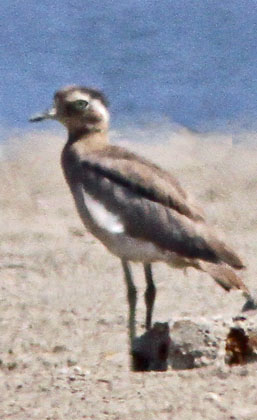 |
|
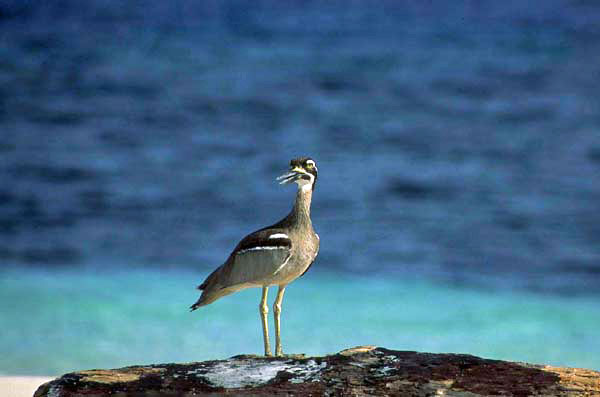
The two thick-knees placed is genus Esacus are Great Thick-knee and Beach Thick-knee (left, in a fine shot by Will Betz from New Guinea). The genus is used for two closely=related birds that are more heavily shoreline foragers than many thick-knees. Both Esacus thick-knees feed primarily on crabs; the Beach Thick-knee dines on them almost exclusively (Hume 1996). Great Thick-knee occurs from Iran to south China. Beach Thick-knee is found along the shores of Australasia, Indonesia, the Philippines, and some southwest Pacific islands.
Beach Thick-knee is exclusively coastal, both on islands and mainland beaches, but is adapted to coral atolls as well as mangroves. Some pairs have been resident on a particular stretch of beach for more than 10 years (Hume 1996). It is a skittish species, generally avoiding people, and is thus an often-prized bird for visiting birds in north Australia or Indonesia. |
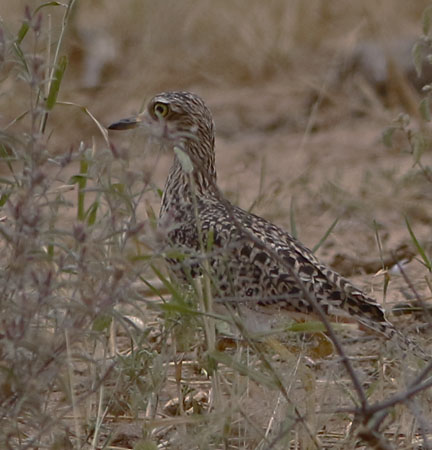 At one time the Burhinidae were considered related to Bustards (Otididae) in the order Gruiformes, but all the recent evidence, both biochemical and structural, shows that they are a distinct group of waders in the Charadriformes (Sibley & Monroe 1990, Fain & Houde 2007, Livezey & Zusi 2007). Many of their dry country adaptations appear to be the result of convergent evolution, which is what made them superficially similar to Bustards. Most recent studies have placed Burhinidae within a clade that also includes Sheathbills [Chionidae] and Magellanic Plover [Pluvianellidae; Hackett et al. 2008, Baker et al. 2007, Baker et al. 2012]. At one time the Burhinidae were considered related to Bustards (Otididae) in the order Gruiformes, but all the recent evidence, both biochemical and structural, shows that they are a distinct group of waders in the Charadriformes (Sibley & Monroe 1990, Fain & Houde 2007, Livezey & Zusi 2007). Many of their dry country adaptations appear to be the result of convergent evolution, which is what made them superficially similar to Bustards. Most recent studies have placed Burhinidae within a clade that also includes Sheathbills [Chionidae] and Magellanic Plover [Pluvianellidae; Hackett et al. 2008, Baker et al. 2007, Baker et al. 2012].
Some species (e.g., Eurasian Thick-knee) are migratory — at least in some of the population — but most are resident birds, moving in response to dry or wet conditions. All thick-knees are silent by day but become very vocal after dark, some giving loud, wailing calls or accelerating series of curlew-like "cur-leeee" calls that die away into the night air. Peruvian Thick-knee is known locally as "Huerequeque," a transliteration of its calls (Hume 1996).
All species breed in pairs or small colonies with the young fed by both parents. The Burhinus thick-knees are social birds and can sometimes be found in flocks of a dozen or so. As previously noted, they are largely nocturnal, and both feeding and social displays take place mostly at night. During the day, one encounters them generally standing around motionless, and often inconspicuously, in the shade of low vegetation. Because of these behaviors, it is not usually very dramatic to see a thick-knee. Their world begins mostly after dark (right, Spotted Thick-knee in thornscrub savanna near dusk).
|
| |
Photos: The first three photos show Water Thick-knee Burhinus vermiculatus: The first two, with Nile Crocodiles, is from Mikumi NP, Tanzania, on 10 July 221; the close-up of Water Thick-knee was at Lake Jipe, Kenya, on 26 Nov 1981. The Great Thick-knee Esacus recurvirostris was along the shore of the Kameng River, Assam, India, on 14 Mar 2019. The Indian Thick-knee Burhinus indicus was at Nameri NP, Assam, India, on 15 Mar 2021. The photos of day-roosting Spotted Thick-knee Burhinus capensis were taken, respectively, at Ruaha NP Tanzania, on 5 July 2021, and at Boulders Bay, near Cape Town, South Africa, on 30 June 2005. The Bush Thick-knee Burhinus grallarius was at Dryandra Reserve, Western Australia, on 4 Aug 20084. The Peruvian Thick-knee Burhinus superciliaris was at Laguna Costera, near Lima, Peru, on 26 Nov 2014. Will Betz photographed the Beach Thick-knee Esacus magnirostris on the Aru Islands, Irian Jaya, Indonesia, in the 1990s. The final Spotted Thick-knee Burhinus capensis was in Tarangire NP, Tanzania, on 8 June 2018.
All photos © Don Roberson, except that one attributed to Will Betz, who holds that copyright (used with permission); all rights reserved.
Bibliographic note: There is no specialized "family book" of which I'm aware, although this family is often covered in books that include shorebirds and allies (e.g., Hayman et al. 1986 and similar more recent entries). An fine overview to the family, with a set a very nice set of photos, is in Hume (1996).
Literature cited:
Baker, A.J., Pereira, S.L. & Paton, T.A. (2007). Phylogenetic relationships and divergence times of Charadriiformes genera: multigene evidence for the Cretaceous origin of at least 14 clades of shorebirds. Biology Letters 3(2): 205–209.
Baker, A.J., Yatsenko, Y. & Tavares, E.S. (2012). Eight independent nuclear genes support monophyly of the plovers: the role of mutational variance in gene trees. Molecular Phylogenetics and Evolution 65(2): 631–641.
Fain, M. G., and P. Houde. 2004. Parallel radiations in the primary clades of birds. Evolution 58: 2558–2573.
Hackett, S.J., R.T. Kimball, S. Reddy, R.C.K. Bowie, E.L. Braun, M.J. Braun, J.L. Chojnowski, W.A. Cox, K. Han, J. Harshman, C.J. Huddleston, B.D. Marks, K.L. Miglia, W.S. Moore, F.H. Sheldon, D.W. Steadman, C.C. Witt, and T. Yuri. 2008. A phylogenomic study of birds reveals their evolutionary history. Science 320: 1763–1768.
Hayman, P., J. Marchant & T. Prater. 1986. Shorebirds: An Identification Guide to the Waders of the World. Croom Helm, London.
Hughes, J.M., and A J. Baker. 1999. Phylogenetic relationships of the enigmatic Hoatzin (Opisthocomus hoazin) resolved using mitochondrial and nuclear gene sequences. Molec. Biol. Evol. 16: 1300–1307.
Hume, R.A. 1996. Family Burhinidae (Thick-knees), pp. 348–363 in Handbook of the Birds of the World (del Hoyo, J., A. Elliott & J. Sargatal, eds). Vol. 3. Lynx Edicions, Barcelona, Spain.
Livezey, B.C., and R. L. Zusi. 2007. Higher-order phylogeny of modern birds (Theropoda, Aves: Neornithes) based on comparative anatomy. II. Analysis and discussion. Zool. J. Linnean Soc. 149: 1–95.
Sibley, C.G., and B.L. Monroe, Jr. 1990. Distribution and Taxonomy of Birds of the World. Yale Univ. Press, New Haven, CT.
|
|
|


 Thick-knees are a small family of terrestrial waders, found in drier country in tropical lands around the world. Other names used for these birds are "Stone-Curlews" or "Dikkops." Eurasian Thick-knee Burhinus oedicnemus is still usually called Stone-Curlew in Europe, and the term Dikkops is still very widely used in southern Africa. The ten species of thick-knees are divided into two genera.
Thick-knees are a small family of terrestrial waders, found in drier country in tropical lands around the world. Other names used for these birds are "Stone-Curlews" or "Dikkops." Eurasian Thick-knee Burhinus oedicnemus is still usually called Stone-Curlew in Europe, and the term Dikkops is still very widely used in southern Africa. The ten species of thick-knees are divided into two genera. 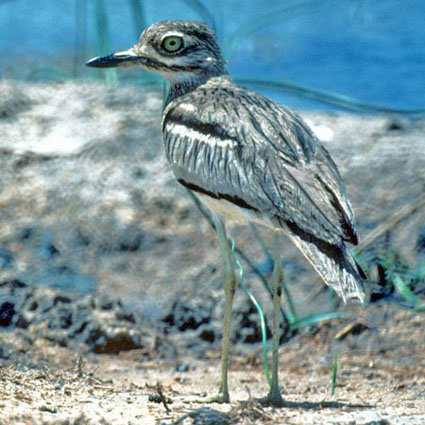







 At one time the Burhinidae were considered related to Bustards (Otididae) in the order Gruiformes, but all the recent evidence, both biochemical and structural, shows that they are a distinct group of waders in the Charadriformes (Sibley & Monroe 1990, Fain & Houde 2007, Livezey & Zusi 2007). Many of their dry country adaptations appear to be the result of convergent evolution, which is what made them superficially similar to Bustards. Most recent studies have placed Burhinidae within a clade that also includes Sheathbills [Chionidae] and Magellanic Plover [Pluvianellidae; Hackett et al. 2008, Baker et al. 2007, Baker et al. 2012].
At one time the Burhinidae were considered related to Bustards (Otididae) in the order Gruiformes, but all the recent evidence, both biochemical and structural, shows that they are a distinct group of waders in the Charadriformes (Sibley & Monroe 1990, Fain & Houde 2007, Livezey & Zusi 2007). Many of their dry country adaptations appear to be the result of convergent evolution, which is what made them superficially similar to Bustards. Most recent studies have placed Burhinidae within a clade that also includes Sheathbills [Chionidae] and Magellanic Plover [Pluvianellidae; Hackett et al. 2008, Baker et al. 2007, Baker et al. 2012].